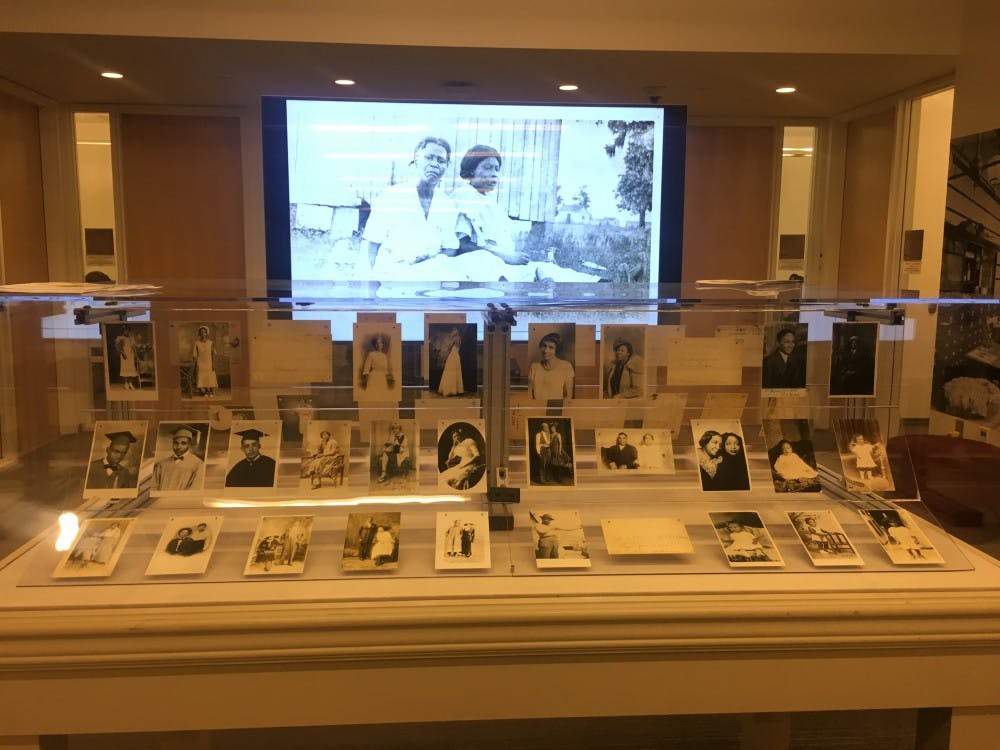Brody Learning Commons is currently hosting a new visual exhibit titled American Selfie, which will be on display until April 6. The exhibit was created by senior Monika Borkovic and junior Lorna Henson as a part of their work for a Museums and Society class.
Located on B-level of Brody, the exhibit displays dozens of selfie-style photo postcards of black Americans from the 20th century. Borkovic and Henson collaborated with the Sheridan Libraries’ African American Real Photo Postcard Collection for physical copies of these photographs.
The students took a class last spring designed to look into special collection archives and browsed through thousands of postcards before selecting the ones displayed for the public.
This is the first exhibit for the collection and will coincide with a visit from Deborah Willis, the chair of the Department of Photography and Imaging at the Tisch School of the Arts. Willis gave a talk on Feb. 7 about the photographic portraits and their relation to race and gender.
“You don’t hear a lot of talk about how other races and genders are portrayed in museums, and you never really think about it,” Henson said. “I wanted to take this class because I wanted to think about something that wasn’t on my radar before.”
Henson said that this project seemed to turn history on its head because it displaced generalized stereotypes about what life was like for black Americans in the 1930s.
“We were taught that African Americans, as a whole, were sharecroppers or very poor factory workers,” Henson said. “The photos show that they were their own human beings. The photos take away this mass generalization and gives [the individuals in the photos] their narratives back.”
Borkovic and Henson wanted to take the information they learned in class and make it accessible to anyone who visits Brody.
Henson said that they asked themselves how they could make campus a more inclusive environment through gender and race portrayal in museums.
The class combed through approximately a thousand photos from the Hopkins archives. Borkovic said that she and Henson were automatically drawn to this theme of postcards while browsing the collection.
Borkovic wanted to design an exhibit that highlighted the physical properties of the postcards so that students could admire them in the way they were originally designed.
“The postcards are very nice to look at,” she said. “We wanted a way to showcase as many as possible.”
Because she and Henson found so many real photo postcards that followed this theme they wanted to display, the solution was to have a monitor behind the physical postcards, playing a slideshow of images they found in the collection.
“There isn’t a whole lot of space on campus where we could showcase a thousand postcards,” Borkovic said.
The exhibit flow is designed so that students can walk around and see the real photo postcards up close, as well as read about the history of the collection.
“Each picture is cool and unique in some right,” Henson said. “[The design] was very crude in its infantry, but all the kinks worked out. I am very proud.”
The exhibit begins with a brief history of this popularized style of postcard. In 1903, Kodak produced an easily accessible camera, and many people took to sending their loved ones images of themselves. The photographs vary in content: Some are very staged; some are graduation photos; and some are of people simply relaxing.
Many of the postcards do not identify their subjects, but the exhibit emphasizes that the true beauty of the artifacts are the images themselves. Gabrielle Dean, a librarian and the William Kurrelmeyer Curator of Rare Books and Manuscripts, believes that the photos are reminiscent of photography today.
“Even the images that are a little more formal, you can see people being themselves,” Dean said.
Henson agreed that even staged photos came off as authentic.
“When I think of the modern day selfie, I think of taking a photo of myself and showing people what I want them to see,” Henson said. “In these photos, we essentially get just that.”





